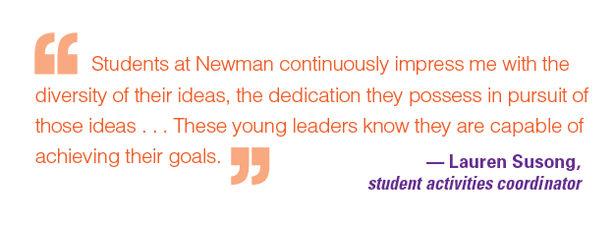A look at Newman students today
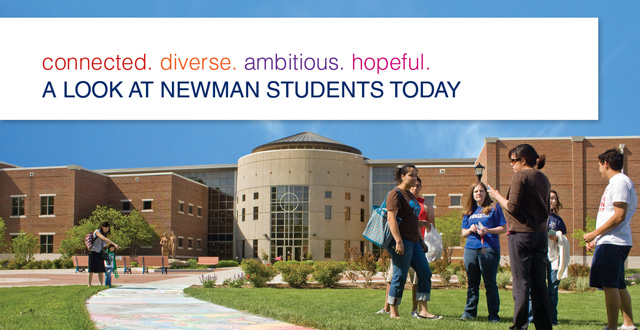 With clockwork regularity, the news media reports on the troubled state of higher education, and the many challenges facing today’s college students.
With clockwork regularity, the news media reports on the troubled state of higher education, and the many challenges facing today’s college students.
Rising tuition costs. Crushing debt. Grim job prospects.
Today’s students live in an era where culture, technology, and the economy are defined by their uncertainty. Yet in spite of these problems and more, students come to colleges in greater numbers than ever before.
Who are the students who come to Newman University? How do the challenges of modern life affect them? Where do they come from, and what do they want?
 The answers to these questions are, of course, complex. Definitive conclusions are impossible and even generalizations can be misleading. Still, a look at the lifestyles, values and aspirations of this ever-changing group offers some interesting and sometimes surprising insights into the nature of Newman students today.
The answers to these questions are, of course, complex. Definitive conclusions are impossible and even generalizations can be misleading. Still, a look at the lifestyles, values and aspirations of this ever-changing group offers some interesting and sometimes surprising insights into the nature of Newman students today.
.
By the numbers
In the fall 2012 semester, 3,108 unique individuals enrolled at Newman, a 2 percent increase over the previous year and the fourth consecutive year of record-breaking enrollments. The student body includes 1,396 undergraduate students, 724 graduate students, and 988 high school students taking Advanced Standing classes. Of the total, 1,571 attend classes on the Wichita campus.
The average ACT score for incoming, new freshman students was 25 – another all-time high.
A full 225 students began their educational journey somewhere else and came to Newman as transfers. Many of these students attended community colleges to complete their general education courses at a lower cost.
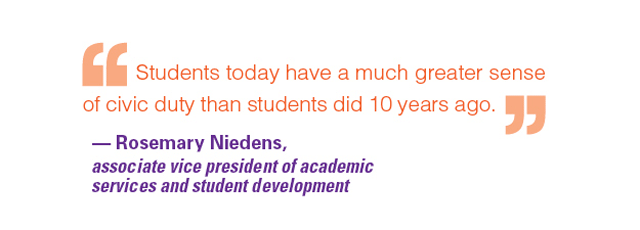
Overall, students come from 23 states, with 293 students from outside Kansas, and 32 countries. Women make up two-thirds of the student body. About 40 percent of students are Catholic. The overwhelming majority, 2,301, are white, while 305 are Hispanic, and 147 are black.
Such diversity has become the hallmark of many schools, but while many students come from afar, still more select Newman because they can stay close to home — In Wichita, three out of four Newman students commute to their classes.
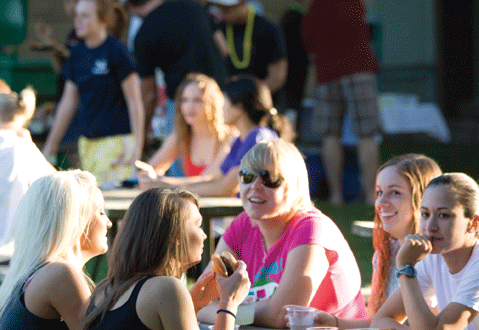
Athletics
Athletic programs draw many students to Newman each year, particularly since the university transitioned to NCAA Division II. Roughly 25 percent of traditional undergraduate students are involved in the 16 sports teams on campus. Soccer, bowling, baseball, basketball, cheer and cross-country have the most participants, with roughly 20 to 35 students on each team.
‘Traditional’ vs adult students
The stereotype of college students being young people fresh from high school holds true for undergraduate students on campus, whose average age is 19. The average age of all Newman students, however, is 25.
As more adults return to college to start or complete a degree, Newman has responded with more programs designed specifically to meet their needs. Newman now offers several programs online or with evening and weekend classes so that adults can earn a degree and still maintain a job and family life. The university also participates in the Yellow Ribbon program that offers veterans an opportunity to attend Newman at little or no cost.
The millennials
The current generation of traditional students, the millennial generation, is experiencing college – and life, in an unprecedented way.
Students today are extremely tech-savvy and extremely connected, with the ability to stay in contact 24/7 with friends and family via social media. Most are in regular contact with their parents, and speak to them on the phone two or three times a week. Some make contact two or three times a day.
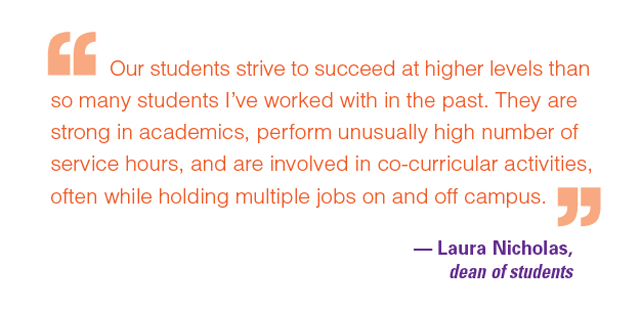 The millennials communicate through e-mail and text messaging as much as in person, and prefer webinars and online technology to
The millennials communicate through e-mail and text messaging as much as in person, and prefer webinars and online technology to
traditional lecture classes.
While it’s common to think of a university forming its students, it is also true that students have a large role in forming the university, and the millennial generation has clearly made an impact on Newman. Cell phones are as common in classrooms as books and pencils, and grades can be checked and tuition paid at any time online, all facilitated by free Wi-Fi on campus.
Newman also has a Facebook page and a Twitter feed, as well as a YouTube channel featuring everything from recruitment videos to short documentaries on students’ experiences abroad. Through these and other services, none of which are new, a level of access to the university that was unheard of less than a generation ago is taken as a given today.
Some say millennials are rule followers because of tighter parental and social control, while others say this generation has an overarching sense of entitlement and view rules as “something for other people.” Whatever their characteristics, pastimes and viewpoints, they are a force to be reckoned with: Within the next eight years, 46 percent of the U.S. workforce will be made up of millennials.
Popular majors
Newman has established its reputation as an excellent school for science and pre-med, which is reflected in the popularity of those majors. Of the six most popular majors among undergraduates on the Newman campus, four fall in the science, health care or pre-med category: nursing, biology, occupational therapy assistant, and radiological technology. Elementary education and business round out the top six.
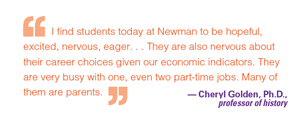 Elementary education and business are also popular degrees for graduate students. Social work attracts many students as well. And though graduate programs in theology were only recently established, these programs, delivered almost completely online, are consistently in high demand.
Elementary education and business are also popular degrees for graduate students. Social work attracts many students as well. And though graduate programs in theology were only recently established, these programs, delivered almost completely online, are consistently in high demand.
Why do students come to Newman?
Though much has changed, both in the world at large and at Newman University in particular, some things have remained constant. Newman’s size and the ease with which students can develop relationships with faculty continue to draw students to the institution. The university’s reputation for quality, and its dedication to service and the Church, are also cited by students as reasons they are attracted to Newman.
The world may change, and students may change with it. Yet it seems clear that students come, and will continue to come, to Newman University because it remains, at heart, what it always has been – a Catholic university with a passionate faculty, serving the Church and the community, and dedicated to empowering graduates to transform society.
.
.
.
.
.
.


